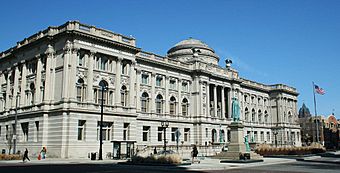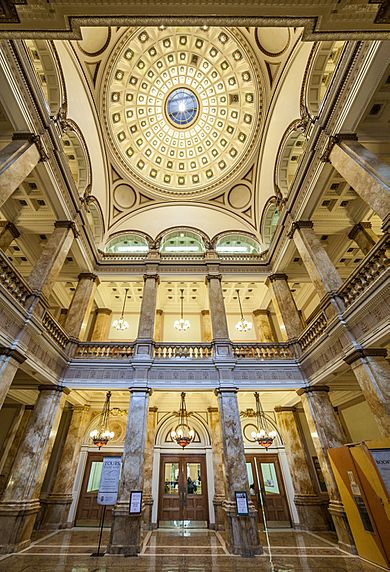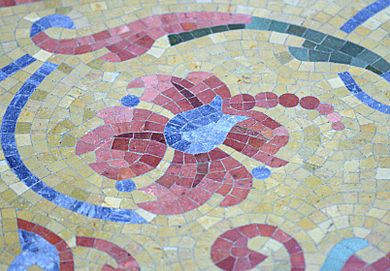Central Library (Milwaukee, Wisconsin) facts for kids
Quick facts for kids |
|
|
Central Library
|
|

Milwaukee Central Library
|
|
| Location | 814 W. Wisconsin Ave., Milwaukee, Wisconsin |
|---|---|
| Built | 1895 |
| Architect | Ferry & Clas |
| Architectural style | Renaissance, Renaissance Revival |
| NRHP reference No. | 74000101 |
| Added to NRHP | December 30, 1974 |
The Central Library is the main building for the Milwaukee Public Library System. It is also home to the Milwaukee County Federated Library System. This amazing building became a Milwaukee Landmark in 1969. It is still one of Milwaukee's most important public buildings.
Today, the Central Library uses almost the entire building. Only a few other groups share the space. These include the Wisconsin Talking Book and Braille Library. Another is Audio & Braille Literacy Enhancement.
Discovering the Central Library's Design
In 1893, a big contest was held. People wanted to find the best design for a new library and museum building. Seventy-four different designs were sent in. Even famous architect Frank Lloyd Wright submitted a plan!
The winning design came from a Milwaukee company called Ferry & Clas. They created a building that takes up a whole city block. Its style mixes French and Italian renaissance designs. This style is also known as Neo-renaissance. The front of the building has many tall columns. These might have been inspired by the Louvre in Paris.
The building was shaped like a "U". This allowed the library and museum to have a shared entrance. But it also kept them separate inside. This huge building cost $780,000 to build. It is now listed on the National Register of Historic Places.
Inside the library entrance, you can see beautiful mosaic tile floors. Italian artists who lived in Milwaukee laid these by hand. They used tiny colored pieces of marble or tile called tessera. These small pieces allowed for very detailed designs. Over the years, the building has settled a bit. This caused some cracks in the floor and columns. In 2008, work began to fix these mosaic floors.
Other materials used inside include yellow Sienna marble. You can also see brass and stained glass in the lights. Hardwoods like oak and mahogany were used. The pillars are made of a material called scagliola. Look closely at the trim above the doors. It has a bay leaf garland design. This design is actually painted plaster, not carved wood!
The Green Roof Project
In 2009, the Milwaukee Metropolitan Sewerage District helped fund a special project. They approved money for the library to build a green roof. This new roof replaced the old one from 1986.
A green roof is a special system. It has a waterproof layer, insulation, and a filter. Then, soil and plants are added on top. The library also put in solar panels. These panels turn sunlight into electricity.
The green roof helps the environment in many ways. It reduces dirty rainwater runoff. It also cools down the city in hot weather. Plus, it helps make the air cleaner. In the long run, Milwaukee will save money on water treatment. You can even take tours of the green roof during certain seasons!
The Old Board Room and Corridor
The Old Board Room is next to where the city librarian's office used to be. This office had a great spot facing Wisconsin Avenue. The Old Board Room looks almost the same as it did when the building opened in 1898. Only the ceiling light fixture was added later.
The furniture in this room is made of hand-carved maple wood. The company Ferry & Clas designed the building. They also planned all the furniture and equipment inside. This room was even used as J. Edgar Hoover's office in a TV movie!
Art, Music and Recreation Department
The Art, Music and Recreation Department was updated in October 1999. At the entrance to this department, there is a mosaic floor. It is called "Unswept Room" and was made by artist Steven Ferren. The hallway leading to this room also has space to display art.
Children's Room
The Children's Room has a special name. It was named for Elizabeth A. Brinn. She was a Milwaukee businesswoman. An anonymous donor asked for the room to be named in her memory.
The room opened on June 8, 1998. It moved from the second floor to the first floor. This space was once used by the Discovery World Museum. The floor is made of navy blue German linoleum. It was designed by Lois Ehlert. Thirty-one different animal shapes in bright colors greet visitors. These animals appear throughout the room. They highlight different areas of interest. The window seat cushions match the navy blue floor. They are trimmed in the same colors as the animals.
A beautiful painted glass window is in the room. It shows scenes from Hans Christian Andersen stories. Marie Herndl designed it, and it was finished in 1896. This window was in the original children's library. It was restored by Conrad Schmidt Studios for the new room.
Amazing Collections to Explore
Art, Music and Recreation
The Art, Music and Recreation Department has many books. These books cover fine arts like painting and sculpture. They also include architecture, movies, and theater. You can find books on photography, music, and sports. There are even books about folklore and UFOs!
This department has a collection of popular sheet music. Some songs go back to the early 1900s. A few even date back to the 1850s, before the Civil War.
The department also has catalogs from major auction houses. These help people identify and price collectibles. You can find guides on toys, coins, comics, and dolls. Other resources include a poster collection. There is also the Wisconsin Architectural Archives. This archive started in 1975. It has over 12,000 drawings and plans. These show the designs of architects who shaped Wisconsin's history.
Children's
The Betty Brinn Children's Room at the Central Library is a special place for kids. It has a huge collection of popular children's books. It's a fun and separate space for children and families.
The room also has listening stations. There's the McBeath theater for programs and puppet shows. The Herzfeld Activity Center is great for presentations. Kids can learn computer skills or do arts and crafts there. The room has 30 computers. They have programs to help with reading, writing, math, and science. The children's room also has full collections of Newbery Medal and Caldecott Medal books. It also features books by Wisconsin authors and illustrators.
Humanities
Librarians at the Humanities Desk help people with many topics. These include religion, philosophy, and psychology. They also cover education, law, and government. You can find books on language, literature, and travel. History, biographies, and family history (genealogy) are also here.
The staff works hard to get, organize, and save materials. Some special parts of this collection are the Local History Collection and the Genealogy Collection. There's also the Great Lakes Marine Collection. The department helps researchers find old records. These include the City of Milwaukee Archives and the Milwaukee Road Archives.
Periodicals
This department has many magazines and newspapers. It also has guides to help you find information. These guides are available in print and online. You can find consumer information here. They also have vehicle values, stock prices, and tax forms.
The Milwaukee Public Library is a special library. It receives thousands of free government publications each year. The library makes these available for everyone to use.
Richard E. and Lucile Krug Rare Books Room
This special area has two parts. There's a reception area and a storage area. The storage area has special controls for temperature and humidity. The room is named after Richard Krug. He was the city librarian for a long time (1941–1975). He started the first rare books room. His wife, Lucile, gave money to build and furnish this new room. It was dedicated in 2001.
Only staff can go into the storage area. But here are some cool things you might find in the collection:
- A complete set of John James Audubon's Birds of America.
- The library's oldest printed book. It's called "Praeceptorium Divinae Legis" from 1479. It's about the Ten Commandments. It has notes written in the margins by students from long ago!
- Other very old books, printed before 1501. One is called "Hypnerotomachia Poliphili" from 1499. It's thought to be the most beautiful book of the Renaissance period.
- The 60-pound Autograph Book. It has 2,283 autographs from famous people around 1898. These include politicians, artists, and musicians.
- "Voices of Friends"—a beautiful handwritten book from 1913. It was made by Milwaukee artist Susan Frackelton and her daughter.
- Letters signed by famous people like Dickens, Beethoven, and Bismarck.
- Old colorplate books from the 1800s and earlier. They show birds, plants, Native Americans, and fashion.
- Examples of unique books from special presses. These include Kelmscott and Doves. They made beautiful handmade books around 1900.
- A famous painting called "The Bookworm" by Carl Spitzweg. It is kept in this room. Lights are only turned on when there is a special program. This helps keep the painting safe. The painting is currently on loan to the Grohmann Museum at the Milwaukee School of Engineering. If you have a Milwaukee Public Library card, you can visit the museum for free!
Business and Technology
The Business and Technology department has information on many subjects. These include science, health, and medicine. You can also find technology and business information. They have patents, trademarks, and statistics.
The Milwaukee Public Library is a special patent depository library. It has U.S. patents from 1792 to today. The library also offers classes. These classes help people learn about patents and trademarks. You can search for patents in different ways here. They have print, microfilm, and CD-ROMs.



